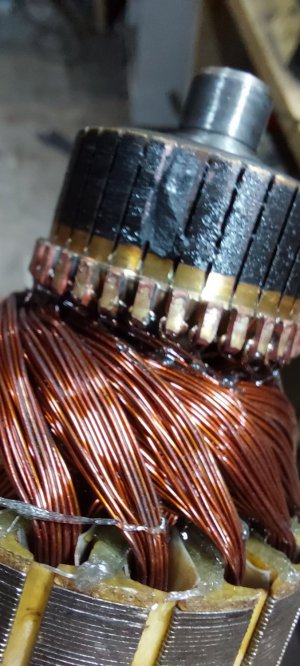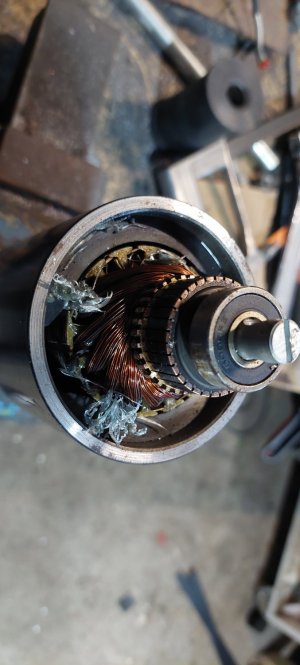-
Welcome back Guest! Did you know you can mentor other members here at H-M? If not, please check out our Relaunch of Hobby Machinist Mentoring Program!
You are using an out of date browser. It may not display this or other websites correctly.
You should upgrade or use an alternative browser.
You should upgrade or use an alternative browser.
Electrical issue with my mini lathe
- Thread starter Houthans
- Start date
- Joined
- Nov 11, 2023
- Messages
- 11
Yyyeeeaaahhh....thats fubar'd. Sorry to hear.Well. I opened it up, and this is what I encountered. View attachment 467941
Bummer. I thought this would be problematic. No chance of sanding that burnt electrode from the copper commutator to try to get it working again? If not, does anyone have any recommendations on a good replacement motor and frequency controller?
- Joined
- Apr 30, 2015
- Messages
- 11,307
Know of anyone who is getting rid of an old exercise treadmill? They often have DC motors in them that can be adapted to
lathe use
Your original motor looks as though the brushes were of a poor quality with high resistance to burn and blacken the commutator like that
The copper segments are usually much more shiny and smooth even after many hours of use.
lathe use
Your original motor looks as though the brushes were of a poor quality with high resistance to burn and blacken the commutator like that
The copper segments are usually much more shiny and smooth even after many hours of use.
Last edited:
How do the brushes and the brush-holders look? You could try to put the rotor between centers on your lathe, turn it by hand and take off some material until the commutator is clean again. But often the coils in the rotor are also burnt.
You could buy a sewing machine servo from ebay. That might be one of the cheapest solutions while keeping an eye on the durability. There are versions with more than 500 watts and they have a controller. In the german Zerspanungsbude there is a Thread where one has shown how to modify the controller unit to control the speed setting with a potentiometer.
You could buy a sewing machine servo from ebay. That might be one of the cheapest solutions while keeping an eye on the durability. There are versions with more than 500 watts and they have a controller. In the german Zerspanungsbude there is a Thread where one has shown how to modify the controller unit to control the speed setting with a potentiometer.
The brushes were broken off; looks like they were fused to the commutator. The brusholders look fine. I did encounter something that looks like molten plastic that was spun around on the inside. I'll share a picture later of that stuff and look into the sewing machine motors. Thanks for that.
Here's an image of the plasticky stuff I found inside. It's the white stuff on the magnets.The brushes were broken off; looks like they were fused to the commutator. The brusholders look fine. I did encounter something that looks like molten plastic that was spun around on the inside. I'll share a picture later of that stuff and look into the sewing machine motors. Thanks for that.
Attachments
- Joined
- Jul 12, 2015
- Messages
- 287
Now would be a good time to upgrade to a VFD. I would be concerned about the electronics that drive that motor, if not now later. A VFD would also be a performance upgrade as well. Cost is not necessarily prohibitive and your already set to spend on the drive system.Here's an image of the plasticky stuff I found inside. It's the white stuff on the magnets.
Don't powered wheel chairs also use powerful DC motors? (Used or failed might be inexpensive.) Right after they were introduced, I recall reading about a fellow who built his own Segway self-balancing transporter. He used wheel chair motors.
I worked on power wheelchairs for many years. Most of them do use PM motors, but run at 24 volts.
Most of the better designs use a motor, coupled to a gearbox, through a coupler.
That means the actual motor shaft is usually small diameter, and short, so you will have to find one that has a longer shaft-and that's be hard to see without taking it apart. The alternative is to figure out a way to make the shaft longer.
I think the damage is probably a combination of running under heavy load, and poor material being used to make the motor.
If the controller has a lot of power, I have seen similar damage when the motor is locked-restrained, and power applied for extended time.
I just finished using an old scooter motor on a lathe, by using a 24 power supply, and motor controller from ebay. So far, it seems to work well.
Hope this helps.
Most of the better designs use a motor, coupled to a gearbox, through a coupler.
That means the actual motor shaft is usually small diameter, and short, so you will have to find one that has a longer shaft-and that's be hard to see without taking it apart. The alternative is to figure out a way to make the shaft longer.
I think the damage is probably a combination of running under heavy load, and poor material being used to make the motor.
If the controller has a lot of power, I have seen similar damage when the motor is locked-restrained, and power applied for extended time.
I just finished using an old scooter motor on a lathe, by using a 24 power supply, and motor controller from ebay. So far, it seems to work well.
Hope this helps.



